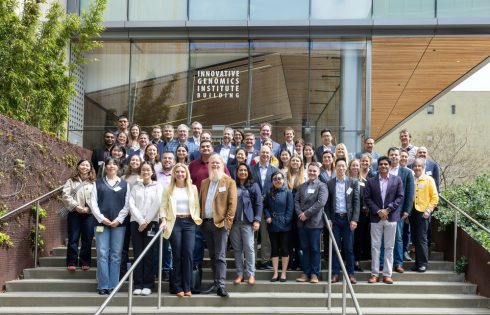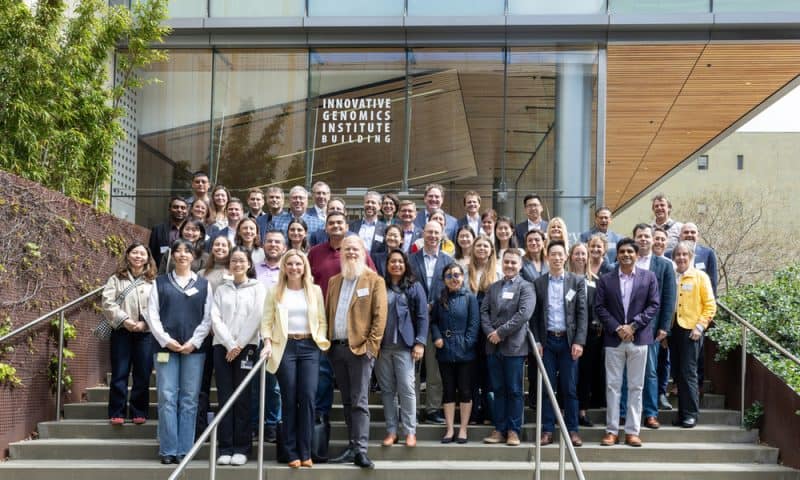
Berkeley—Nobel Laureate Jennifer Doudna, PhD, professor of biochemistry, biophysics, and structural biology at UC Berkeley, aspires for “CRISPR to become the standard of medical care for certain diseases” when asked for her dream for the technology in the next 5–10 years.
That dream has recently been challenged by a volatile climate, with public gene editing companies losing value in the past year, despite evidence of treatments showing efficacy. Funding has become a challenge for gene editing start-ups with companies cutting staff and trimming pipelines.
Recently, CRISPR leaders across the Innovative Genomics Institute (IGI) ecosystem, which spans multiple California institutes and hospitals including UCSF, Benioff Children’s Hospital, and UCLA, came together to change the tone by celebrating the one-year anniversary of the Danaher-IGI Beacon for CRISPR Cures collaboration, 10 years after IGI’s founding.
Fyodor Urnov, PhD, professor of molecular and cell biology at UC Berkeley and director of technology & translation at IGI, who recently authored a 6,000-word editorial in The CRISPR Journal to “give Cas a chance,” said the pioneers of CRISPR gene editing have built an electric car in a universe that was built for early model internal combustion engines.
“It is not the first time in the history of technology that we have invented something, but parts of the world have not caught up,” said Urnov in an interview with GEN. “In this case, CRISPR fundamentally can do what we wanted to do, but a good chunk of the regulatory environment, for example, putting CRISPR into a person, hasn’t changed in 15 years.”
The Danaher partnership enables a new research program at the IGI and is also the largest investment yet from the Danaher Beacons program, which funds pioneering academic research with the goal of developing innovative technologies and applications for human health.
Among the event speaker line-up were Don Kohn, MD, distinguished professor of microbiology at UCLA, Jennifer Puck, MD, professor emeritus of pediatrics at UCSF, Tippi MacKenzie, MD, professor of surgery at Benioff Children’s Hospital and professor of children’s health at UCSF, and more.
The collaboration, set to span a total of four years, provides the IGI team with support from Danaher and several of its operating companies, including Integrated DNA Technologies, Cytiva, Beckman Coulter Life Sciences, and Aldevron.
“Our mission in academic science is to create new things and explore new ideas. What we’re not good at is developing ideas so that they can be widely available, affordable, and disseminated,” said Doudna. “This partnership is our effort to bring those two areas together so that CRISPR can have a global impact.”
Urnov said the world is not a “magical machine” for distributing technology equitably and fairly, such that suddenly everyone benefits from the best. “There is no magic wand that enables a technology to change the world,” Urnov told GEN. “The Danaher partnership is about realizing that fact for CRISPR gene editing and building it into a technology that will fundamentally change how we treat a large class of human diseases.”
CRISPR cookbook
Urnov emphasized that the goal of the partnership is to develop a robust clinically validated “cookbook” that contains solutions and sources for how to develop CRISPR cures for your disease of interest.
Upon launch, the collaboration was initially aimed to drive two preclinical gene-editing therapies from design to initial regulatory submission, with a focus on a family of rare and genetic immunological disorders known as inborn errors of immunity (IEIs), including two diseases known as ARTEMIS-deficient severe combined immunodeficiency (ART-SCID) and hemophagocytic lymphohistiocytosis (HLH). IEIs have several advantages that the collaborators believe make them amenable to the center’s approach, including an extensive patient registry and a transplant-based route of administration that bypasses key challenges in delivering CRISPR molecules to appropriate tissues.
According to Danaher, the Beacon for CRISPR Cures will be designed to yield a “stacked” manufacturing platform for gene editing therapies and increase the number of patients treated with CRISPR-based technology from approximately 210 patients to many thousands over the next decade.
Sadik Kassim, PhD, CTO, genomic medicine at Danaher, highlighted that the Danaher IGI Beacon was selected by the Alliance for Regenerative Medicine as a keystone program at the FDA Scientific Exchange for Advancing Gene Editing Platforms for Rare Diseases held last November. The recognition showcased impactful platforms that transform scientifically feasible treatments into commercially viable options.
“To be able to tell the world ‘this is what needs to happen’ within a year time frame, with Danahar and IGI at the forefront, is an important milestone, in addition to the actual operationalization of this entire concept,” Kassim told GEN.
Kassim also noted that the collaboration has captivated the attention of many other academic centers with several wanting to apply or contribute to the “cookbook” concept.
“Hopefully the collaboration will be a catalyst for a bigger convergence between the entire community, with Danaher and IGI being the center of that entire constellation,” Kassim continued.
Danaher has yet to comment publicly on future milestones for the collaboration, but noted that it expects more news to be announced at the 2025 American Society of Gene & Cell Therapy (ASGCT) meeting being held this coming May in New Orleans.

